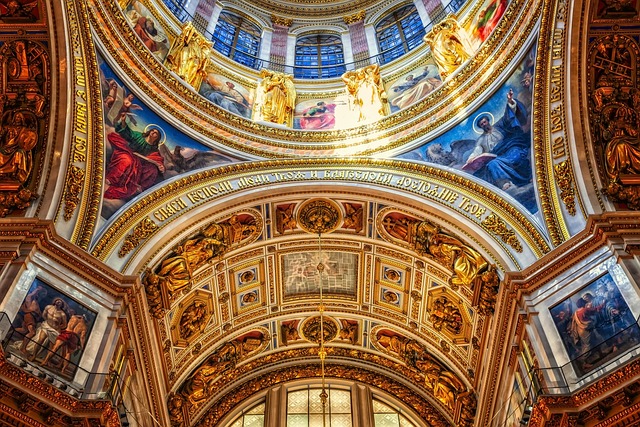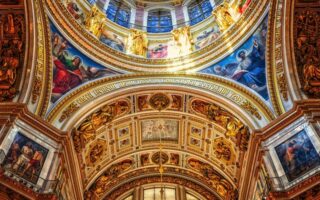The Orthodox Church, also known as the Eastern Orthodox Church, is one of the three major branches of Christianity, alongside the Roman Catholic Church and Protestantism. It traces its origins back to the early Christian community in the Eastern Roman Empire, with its roots in the teachings of Jesus Christ and the apostles. The Orthodox Church places a strong emphasis on tradition, liturgy, and the authority of the bishops. It is characterized by its rich theological and spiritual heritage, distinctive worship practices, and its commitment to preserving the teachings and practices of the early Christian Church.
Table of Contents
History and Origins of the Orthodox Church
The Orthodox Church, also known as the Eastern Orthodox Church, is one of the oldest Christian denominations in the world. Its history and origins can be traced back to the early days of Christianity, making it a fascinating subject to explore.
The roots of the Orthodox Church can be found in the early Christian communities that emerged in the eastern part of the Roman Empire. These communities were deeply influenced by the teachings of the apostles and the early fathers of the Church. Over time, they developed their own distinct traditions and practices, which set them apart from the Western Christian Church.
One of the defining moments in the history of the Orthodox Church was the Great Schism of 1054. This event marked the formal split between the Eastern Orthodox Church and the Roman Catholic Church. The primary cause of the schism was a disagreement over the authority of the Pope and the use of unleavened bread in the Eucharist. While the Roman Catholic Church recognized the Pope as the supreme authority, the Orthodox Church believed in a more decentralized structure, with each local church having its own autonomy.
Despite the schism, the Orthodox Church continued to thrive and spread throughout the Byzantine Empire and beyond. It played a crucial role in shaping the religious, cultural, and political landscape of the regions it reached. The Byzantine Empire, with its capital in Constantinople, became the center of Orthodox Christianity, and the emperors were seen as the protectors of the faith.
Throughout its history, the Orthodox Church has faced numerous challenges and obstacles. It has survived invasions, persecutions, and political upheavals. One of the most significant challenges came with the rise of Islam in the seventh century. Many territories that were once part of the Byzantine Empire fell under Muslim rule, leading to the decline of the Orthodox Church in those regions.
Despite these setbacks, the Orthodox Church has managed to preserve its traditions and teachings throughout the centuries. It has remained steadfast in its commitment to the early Christian faith and has continued to be a source of spiritual guidance and inspiration for millions of believers.
Today, the Orthodox Church is a global community with millions of members spread across different countries and continents. It is known for its rich liturgical traditions, beautiful icons, and mystical spirituality. The Divine Liturgy, the central worship service of the Orthodox Church, is a solemn and awe-inspiring experience that transports the worshipper into the presence of God.
In recent years, the Orthodox Church has also made efforts to engage with other Christian denominations and promote unity among Christians. Ecumenical dialogues and joint initiatives have been undertaken to foster understanding and cooperation between different branches of Christianity.
In conclusion, the history and origins of the Orthodox Church are deeply intertwined with the early days of Christianity. Its distinct traditions and practices have been shaped by centuries of faith and devotion. Despite the challenges it has faced, the Orthodox Church has remained a vibrant and influential force in the world of Christianity. Its rich history and spiritual heritage continue to inspire and guide believers today.
Key Beliefs and Doctrines of the Orthodox Church

The Orthodox Church is one of the oldest Christian denominations in the world, with a rich history and a unique set of beliefs and doctrines. In this article, we will explore some of the key beliefs and doctrines of the Orthodox Church.
One of the central beliefs of the Orthodox Church is the belief in the Holy Trinity. Orthodox Christians believe in one God who exists in three persons: the Father, the Son (Jesus Christ), and the Holy Spirit. This belief is rooted in the teachings of the early Church Fathers and is considered a fundamental doctrine of the Orthodox faith.
Another important belief of the Orthodox Church is the belief in the Incarnation. Orthodox Christians believe that Jesus Christ, the Son of God, became fully human while still remaining fully divine. This belief is central to the Orthodox understanding of salvation and the role of Jesus Christ as the savior of humanity.
The Orthodox Church also places a strong emphasis on the sacraments. Sacraments are seen as visible signs of God’s grace and are considered essential for the spiritual life of the believer. The Orthodox Church recognizes seven sacraments, including baptism, chrismation (confirmation), the Eucharist (also known as Holy Communion), confession, marriage, holy orders, and anointing of the sick.
In addition to these sacraments, the Orthodox Church also places a great deal of importance on the veneration of icons. Icons are religious images that are used as aids to prayer and worship. Orthodox Christians believe that icons are not idols to be worshipped, but rather windows into the divine. Icons are seen as a way to connect with the spiritual realm and to experience the presence of God.
The Orthodox Church also has a strong belief in the intercession of saints. Orthodox Christians believe that the saints, who have lived holy lives and are now in the presence of God, can intercede on behalf of the living. Saints are seen as spiritual guides and role models, and their lives are celebrated and remembered through the veneration of their relics and icons.
Another important aspect of Orthodox belief is the concept of theosis, or deification. Theosis is the process by which a person becomes united with God and attains a share in his divine nature. This concept is rooted in the belief that God became human in Jesus Christ so that humans could become like God. Theosis is seen as the ultimate goal of the Christian life and is achieved through a life of prayer, repentance, and participation in the sacraments.
In conclusion, the Orthodox Church has a rich set of beliefs and doctrines that have been passed down through the centuries. From the belief in the Holy Trinity to the veneration of icons and the intercession of saints, these beliefs and practices are central to the Orthodox understanding of the Christian faith. Whether it is through the sacraments, the veneration of icons, or the pursuit of theosis, Orthodox Christians seek to deepen their relationship with God and grow in holiness.
Worship and Liturgical Practices in the Orthodox Church
The Orthodox Church is known for its rich and vibrant worship and liturgical practices. These practices have been passed down through generations and are deeply rooted in tradition. In this article, we will explore some of the key aspects of worship in the Orthodox Church.
One of the most distinctive features of Orthodox worship is the use of icons. Icons are sacred images that depict Christ, the Virgin Mary, and various saints. They are not seen as mere decorations, but rather as windows into the divine. Orthodox Christians venerate icons by kissing them or bowing before them, believing that they provide a connection to the spiritual realm.
Another important aspect of Orthodox worship is the use of incense. Incense is burned during services to symbolize the prayers of the faithful rising up to heaven. The sweet aroma fills the church, creating a sense of reverence and holiness. The use of incense is also believed to purify the air and ward off evil spirits.
Orthodox worship is characterized by its emphasis on the senses. The liturgy is a feast for the eyes, ears, and nose. The church is adorned with beautiful icons and frescoes, and the chanting of hymns fills the air. The use of incense adds a fragrant element to the experience. All of these sensory elements work together to create a deeply immersive worship experience.
The liturgical practices of the Orthodox Church are also marked by their structure and order. The Divine Liturgy, the central worship service of the Orthodox Church, follows a set pattern that has remained largely unchanged for centuries. It consists of prayers, scripture readings, hymns, and the Eucharist. The priest leads the congregation through each part of the liturgy, guiding them in their worship.
Orthodox worship is highly participatory. The congregation is actively involved in the liturgy, responding to the prayers and singing the hymns. The use of chant is a distinctive feature of Orthodox worship. The hymns are sung in a monophonic style, with a single melodic line. This style of singing creates a sense of unity and harmony among the worshippers.
The Orthodox Church also places a strong emphasis on the sacraments. The sacraments are seen as tangible signs of God’s grace and presence. The most important sacrament is the Eucharist, also known as Holy Communion. In the Orthodox Church, the Eucharist is celebrated at every Divine Liturgy. It is believed to be the true body and blood of Christ, and receiving it is a deeply spiritual experience.
In addition to the Eucharist, the Orthodox Church also celebrates other sacraments, such as baptism, chrismation, confession, marriage, and ordination. Each sacrament is accompanied by specific prayers and rituals, which are performed by the priest. These sacraments are seen as transformative moments in the life of the believer, bringing them closer to God and the community of believers.
In conclusion, worship in the Orthodox Church is a rich and immersive experience. From the use of icons and incense to the participatory nature of the liturgy, every aspect of worship is designed to draw the believer closer to God. The sacraments play a central role in Orthodox worship, providing tangible signs of God’s grace. Whether through sight, sound, or smell, Orthodox worship engages the senses and invites the faithful into a deeper experience of their faith.
Role of Icons and Sacred Art in the Orthodox Church
The Orthodox Church is a branch of Christianity that has a rich history and a unique set of beliefs and practices. One of the most distinctive aspects of the Orthodox Church is its use of icons and sacred art. Icons are religious images that are used as aids in worship and as a means of connecting with the divine. They play a central role in the spiritual life of Orthodox Christians and are considered to be windows into the heavenly realm.
In the Orthodox Church, icons are not seen as mere decorations or works of art, but as sacred objects that have the power to convey the presence of God. They are believed to be a means of communication between the earthly and heavenly realms, and are venerated as such. Icons are often placed in the front of the church, where they can be easily seen and venerated by the faithful.
The use of icons in the Orthodox Church can be traced back to the early days of Christianity. In the early centuries of the Church, when many people were illiterate, icons served as a way of teaching the faith and conveying the stories of the Bible. They were used to depict scenes from the life of Christ, as well as the lives of the saints. Icons were also used to depict theological concepts and to convey the mysteries of the faith.
Icons are not only used in the worship services of the Orthodox Church, but also in the homes of Orthodox Christians. Many Orthodox families have a special corner in their homes dedicated to icons, where they can pray and venerate them. Icons are often passed down from generation to generation, and are considered to be a precious family heirloom.
The creation of icons is a highly skilled and sacred art form in the Orthodox Church. Iconographers, the artists who create icons, undergo years of training and follow strict guidelines in order to create icons that are considered to be spiritually and aesthetically pleasing. The process of creating an icon involves prayer, fasting, and a deep spiritual connection with the subject of the icon.
The use of icons in the Orthodox Church is not without controversy. Some Christian denominations, particularly those in the Protestant tradition, view the veneration of icons as a form of idolatry. They argue that the veneration of icons detracts from the worship of God and places too much emphasis on created objects. However, Orthodox Christians believe that the veneration of icons is not idolatry, but rather a way of honoring and connecting with the divine.
Icons and sacred art play a vital role in the spiritual life of the Orthodox Church. They serve as a means of connecting with the divine and conveying the mysteries of the faith. Icons are not mere decorations, but sacred objects that are venerated and treated with reverence. The creation of icons is a highly skilled and sacred art form that requires deep spiritual connection and devotion. While the use of icons may be controversial in some Christian traditions, they are an integral part of the Orthodox Church and its worship.
Conclusion
The Orthodox Church is one of the oldest Christian denominations, tracing its roots back to the early days of Christianity. It is characterized by its adherence to traditional liturgical practices, sacraments, and teachings. The Orthodox Church places a strong emphasis on the authority of Scripture, the importance of the sacraments, and the veneration of saints. It is known for its rich spiritual and theological traditions, as well as its strong sense of community and unity. Overall, the Orthodox Church plays a significant role in the religious and cultural landscape of many countries around the world.
For licensing reasons, we must provide the following notice: This content was created in part with the help of an AI.


